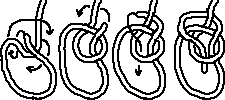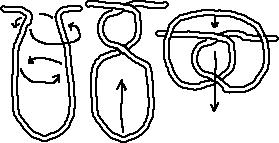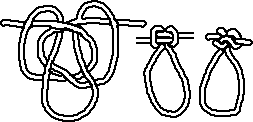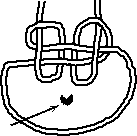![]()
Standard copyrights and disclaimer. Single loops (
|
![]()

The Bowline Knot is one of the most used loop knots. This variant is most used in the
world. Probably due to its simplicity, security, and its relationship with the Sheet bend.
Keep the cross point in step A between a finger and thumb and make a clock-wise turn with
your wrist. Without the loop in between, it is the same knot.
If the loop is expected to be heavily loaded, the bowline is, in fact, not secure enough.
There is a rule of thumb which states that the loose end should be as long as 12 times the
circumference for the sake of safety.

The Dutch Navy uses this variant of the bowline. And, of course, the Dutch sailor says
this one is superior. The working end is not so easy pushed back by accident, they say. I
think it is just a difference in culture.
There is a rule of thumb which states that the loose end should be as long as 12 times the
circumference for the sake of safety.

The double eight is a knot used by climbers. It is easy to tie and safer as the
bowline. There is a discussion whether there should be a stopper at the end of the loose
end or not. Speed of (un)tying is a safety factor itself.
The first way of tying is equal to the way of tying the flamish
eight, but now in a double rope. The 'loose-end' is the loop. This way is only
applicable when the loop is 'empty' during tying.
 If the loop is to be tied round something (round "your waist" for
instance) you first tie an eight then lay the loop and double the eight. It is important
to have enough rope for the loop. It requires experience, so start practicing.
If the loop is to be tied round something (round "your waist" for
instance) you first tie an eight then lay the loop and double the eight. It is important
to have enough rope for the loop. It requires experience, so start practicing.
The Double
Figure-of-eight loop on the WEB.
 The Bowstring Knot
is an ancient knot that is used as an eye for bowstrings. The knot is simple and strong.
Once tied and pulled firmly, you do not want to untie it: you might call it a good
'tie-once' loop knot.
The Bowstring Knot
is an ancient knot that is used as an eye for bowstrings. The knot is simple and strong.
Once tied and pulled firmly, you do not want to untie it: you might call it a good
'tie-once' loop knot.
The bowstring knot is appreciated because it is small, strong, secure, and easy to tie.
It's neat because it does not have loose ends.
Modern archers prefer fixed spliced loops.
If the loose (cross marked) end is not secured within the loop between the bow and loop,
it is wise to add a small overhand knot as
stopper.
The Bowstring Knot
on the WEB.
 If you need a
good looking and strong loop this is a good candidate. The Loose end must be at least two
to three rope diameters long. But if you make the loose end inflexible with for instance
glue, resch or by melting and you can hide it almost completely inside the two round
turns. The "tucked double overhand" is a permanent loop. It jams badly, but
thatīs what it is made for.
If you need a
good looking and strong loop this is a good candidate. The Loose end must be at least two
to three rope diameters long. But if you make the loose end inflexible with for instance
glue, resch or by melting and you can hide it almost completely inside the two round
turns. The "tucked double overhand" is a permanent loop. It jams badly, but
thatīs what it is made for.

An excellent easy to tie loop for applications needing a loop in another place than the
rope-end, but somewhere in the middle. It has an excellent lead, and is secure even if the
forces on both ends are stronger than the load in the loop.
The Butterfly loop
on the WEB.



A practical and easy to tie loop for applications needing a loop in another place than
the rope-end but somewhere in the middle. It is not as strong as the butterfly but is a bit faster to tie and untie. As the name
already suggests it was used by the artillery (for carrying their guns over the shoulder.)
Do not pull the rope too hard when the loop is not loaded. It is best used as temporary
knot for carrying things. As always, work up the knot neatly!
The Artillery loop on
the WEB.

A hitch to tie a pebble or a breastplate to a necklace. You have to make sure the
object is secured in the loop. If you use a loop (this loop) to tie a pebble or other nice
stone to a neck loop without extra (visible) support it is wise to use a leather neck
loop. Make a cut in the length of the inside of the loop. Not too deep; it is only to
roughen the surface to improve the grip of the knot. And last but not least..... use a
good shoemakers glue. The result is surprising.
The pendant hitch is closely related to the The True Lovers
or Fisherman's Knot.
![]()
Because this is an non-commercial site I can and will not allow junk mail nor spam. Therefor commercial, non-personal and bulk mail will be charged with a handling cost of $100 per mail.